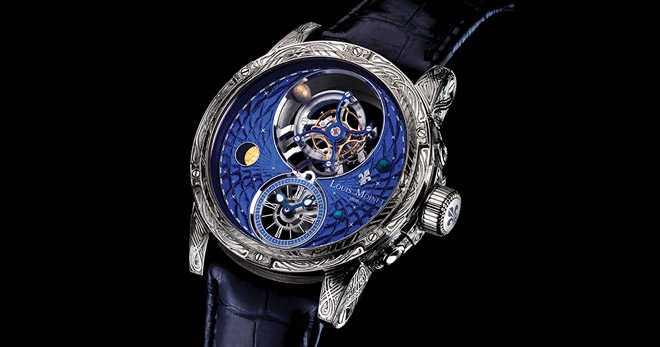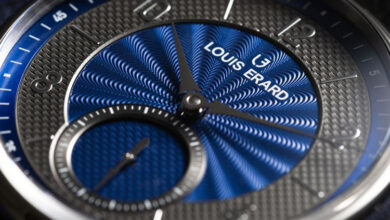Mysterious tales from Louis Moinet

Art, at its most creative, uses imagery to tell tales; the atelier of Louis Moinet once again confirms its perception of haute horlogerie as a combination of art, craft, and technology. The latest creations from Louis Moinet carry tales from the mysterious space and the origins of life in magical colours, while paying homage to the imaginative watchmaker after whom it is named
Space Mystery
Space Mystery is the world’s first “satellite tourbillon”: the cage is balanced by means of a planet that rotates around it. And this is just one of several exclusive Louis Moinet features in this piece; Space Mystery also includes authentic fragments of a mysterious meteorite from the far-flung regions of space that holds traces of amino acids – possibly one of the first forms of life in the universe. This unique watch is showcased on a dial in Magic Blue – a colour whose exact composition remains a closely guarded secret. This hue endows Space Mystery with all the depth of the cosmos so dear to Louis Moinet.

After having shown off fragments of the Moon, Mars, and the oldest known rock in the solar system, Ateliers Louis Moinet is now presenting the carbonaceous CM chondrite meteorite, which may possibly be the proof of life in space. The meteorite in question contains amino acids – the basic requirement for all life forms, vital for all metabolic processes. Space Mystery is the first timepiece in the world to include these authentic fragments bearing traces of amino acids – perhaps the very first known sign of life in the cosmos.
According to Jean-Marie Schaller, CEO and Creative Director of Louis Moinet, the origin of the carbonaceous CM chondrite meteorite is a mystery. He goes on to explain that the presence of non-terrestrial amino acids could indicate that it originated outside our solar system over 4.5 billion years ago. He elaborates that it was an exceptional creative catalyst for the marque – and represented a huge responsibility, too, as it’s not every day that you get a chance to display the origins of life in the Universe.
Space Mystery is the theatre for this display. The 46 mm-diameter watch offers many other exclusive features, the fruit of almost two years of development. The first, and no doubt the most visible, is the Magic Blue dial. The blue is unlike anything achieved using enamel, lacquer, or galvanisation. It offers unique depth and power, evocative of the immensity of the galaxy.

An outsize tourbillon is located at 12 o’clock. Its balance wheel and bridge have been crafted in authentic Louis Moinet style; the upper part is in blued titanium. The tourbillon cage, boasting an exceptional diameter of 13.59 mm, hangs suspended in mid-air, 1.8 mm above the dial. Not only does this satellite tourbillon – also exclusive to Louis Moinet – rotate on its own axis, it is itself in orbit, as is its very own satellite planet, revolving every 60 seconds. What is more, contrary to existing off-axis tourbillons, the axis of rotation of the Space Mystery tourbillon is not the same as that of the hours and minutes hands.
At 9 o’clock sits Space Mystery’s most singular aspect of all: an aperture in the dial houses an authentic fragment of the amino acid meteorite. This is something that goes beyond watchmaking alone according to Schaller, a universal message on our very origins. Space Mystery is much more than a journey; it seeks to answer the question of where did we come from. Space Mystery contains a tiny glimpse of an answer to a question that transcends humankind.
The Space Mystery case is entirely hand-engraved and hand-polished. On either side of the crown, each case band will include two other authentic fragments of heavenly bodies – one from Mars and the other from the Moon. There will be four editions of Space Mystery, each comprising 8 watches (2 in white gold, 2 in rose gold).
This is a limited edition of 8, because the latter is a visual reminder of the infinity symbol. Invented by the mathematician John Wallis in 1655, its shape is similar to the figure 8-shaped plane curve known as the lemniscate of Bernouilli.
The origins of life?
Amino acids are organic compounds that play a vital role in the cell structure of all known living organisms. To date, some 500 different types of amino acid have been identified. Only 140 are capable of producing proteins, 20 of which form part of the makeup of human DNA. They all contain the four basic elements of life: carbon, oxygen, hydrogen, and nitrogen.
The best-known CM chondrite is the Murchison meteorite that fell to earth in Australia in 1969. Analysis of the meteorite has led scientists to conclude that it alone contained over 200 different amino acids – the probability that it contains the first traces of non-terrestrial life is thus non-negligible.
Nobody yet knows exactly where this meteorite came from. The presence of non-terrestrial amino acids could indicate that it came from outside our solar system, over 4.5 billion years ago. Another theory is that it came from a comet or from the asteroid belt between the orbits of Mars and Jupiter.
Mobilis
Mobilis is the first and only Double Tourbillon whose function is to power a watch complication – the first patent application of its kind. To achieve this, two huge tourbillon cages, each with a diameter of 14.9 mm, had to be designed. What’s more, one had to rotate clockwise and the other, counter-clockwise (second patent application). And most importantly of all, they had to be crafted from cutting-edge materials, so that they could be as light as possible (0.4 gr per cage) while still providing the force required to bring the watch complication to life.

The magic of the optical illusion is based on the kaleidoscope complication at 12 o’clock. Its architecture is composed of two cut-out discs: one atop the other, they are driven by an inverted gear system, together revealing a captivating optical effect.
The skeleton-working performed on the mechanism pares it down to its purest possible expression. Suspended in mid-air, the tourbillons drive the kaleidoscope with its two discs made of titanium, a material whose extreme lightness is crucial in enabling a 60-second rotation of the discs.
The movement is housed in an avant-garde case featuring a new, intricate design. The two side shafts are crafted from blocks of solid gold, sculpted and embellished with black zircons. Boasting a power reserve of 52 hours, the watch is water resistant to 30 M.
Memoris Red Eclipse
The most prestigious version of Memoris is back – Red Eclipse. Now boasting a rose gold case and fully hand-engraved, with a lunar eclipse theme, this new interpretation wonderfully offsets the dominant blue of the astral micro-painting that adorns the dial. The new version of Memoris has the same distinctive characteristic as the earlier models: making the chronograph the primary function of the timepiece, instead of just a complication.
After three years of developments, Ateliers Louis Moinet went about things just as the inventor of the chronograph did in his day: taking a completely different approach to watchmaking, rather than attempting merely to improve on an existing model. Indeed, that’s how Mr Louis Moinet himself invented the chronograph and was the first to incorporate the use of high frequencies – just one of his many remarkable achievements.

Memoris shifts the whole of the chronograph function to the dial, structuring it around three guiding principles: locating the chronograph centre stage; giving it a traditional clutch column wheel; and adding a monopusher – just like Mr Louis Moinet’s very own Compteur de Tierces, the first chronograph in history (1816).
The chronograph’s action can be admired in its entirety by activating the pusher. The column wheel orchestrates the graceful ballet of the mechanism of steel and gears, passing information to the hands. The chronograph reigns in splendid isolation on the dial, leaving the beholder in no doubt that it is neither a skeleton nor an additional component: the new movement has been designed for and around the chronograph. To complete the picture, Louis Moinet has opted to locate the traditional workings of the automatic mechanism on the back of the movement, beneath the plate. Its oscillating weight is decorated with a red moon in gold-leaf enamel.
The calibre on Memoris is the LM54. Beating at a rhythm of 28,800 vibrations per hour (4Hz), it boasts 302 components and a 48-hour power reserve. Over 60 parts have been designed and manufactured to allow the chronograph to be presented atop a dedicated movement plate, separating it from the automatic movement beneath.
“Energie Plus” is an ingenious, automatic pawl-winding system featuring an elegant spring with a ‘crab claw’ design. And to complete the assembly, a miniature ceramic ball bearing is mounted on the dual-material rotor. The advantage of Energie Plus is that it allows the piece to be wound up in both directions, with a minimum of excess travel. This optimises each movement of the rotor, recovering its energy, and winding the movement more effectively.
On the dial, Memoris’ starry base consists of a brass plate coated in a translucent blue. The stars have been created using an entirely new fixed graver process. Devised by one of Louis Moinet’s craftsmen, it involves attaching a specially made lathe to a traditional rose engine (also known as a guillocheuse).
The idea is to combine the power of the rose engine with the precision of a handheld graver. The result differs from that produced by milling or stamping: while it resembles the effect traditionally associated with a guillocheuse inasmuch as material is removed, here this is focused on a tiny area with varying levels of depth – two characteristics that traditional engine turning seeks to avoid at all costs.
What is more, individual stars are all fashioned to feature different angles and depths, so that each and every one captures as much light as possible. Several fixed graver sessions are required per star. The process used is unprecedented in watchmaking – and the outstanding result gives the novel impression of stars that really are shining.
The rose gold case is also fully hand-engraved, and decorated with jewels at the end of the lugs. The time is displayed on a dark blue grand feu enamel dial. The rose gold “Red Eclipse” Memoris comes in a limited edition of 12 pieces.
Metropolis – Black & Red or Magic Blue
Metropolis, the new creation by Ateliers Louis Moinet, is back in two new versions – one combining red and black, the other in Magic Blue. The urban, architectural ethos of the timepiece is further enhanced by a contemporary sparkle unlike anything ever seen before from Louis Moinet.
The new Black & Red Metropolis sports a black DLC case, a black dial, and red hour markers. The resulting contrast gives Metropolis a contemporary dynamic and a sport chic ethos bursting with fresh assertiveness.

The Magic Blue Metropolis comes housed in a steel case, and features a Magic Blue dial and rhodium-plated hour markers with white lacquer. The Magic Blue hue is owned outright by Louis Moinet, its composition a closely guarded secret. Far more than just a colour, it provides depth and focus going far beyond a mere variation in shade. The end result is that the Magic Blue Metropolis is redolent with a unique emotion, at once intense and gentle.
Each of the two timepieces bears the hallmark attributes of Metropolis. First off, there are three pieces of openwork, for the hour markers, the dial, and the lugs and vertical bridges, giving the watch a unique three-dimensional splendour. The Roman numeral hour markers are the first recipients of the openwork treatment, and are themselves a first for a Louis Moinet timepiece:
Light dances off each hour marker’s three differently shaped faces. Each side sports a diamond-cut, satin-finish section that reflects light deep, deep into the dial, setting the timepiece sparkling with life. The colour contrast is enhanced by each hour marker being lacquer-coated.
The hour markers are suspended in mid-air, adding a further sense of depth. In a rare feat of craftsmanship, each marker is linked to a central ring and a dark grey flange made from neoralithe. This produces an effect of depth, with the numerals raised above a sand-blasted black base.
The LM45 calibre, boasting a 48-hour power reserve, is completely new, and was designed and assembled in accordance with the firm’s most stringent chronometric requirements. Between 8 and 12 o’clock, the escapement (beating at a rhythm of 28,800 vibrations per hour) and the offset seconds hand are displayed in all their glory, thanks to a second piece of openwork – and carefully arranged to ensure an unobstructed view of every detail of the Metropolis’ workings.
The movement’s finishes embody all the noble traditions of fine watchmaking: Côtes de Genève, diamond-cut angles, circular-grained wheels, and pearling. The sapphire case back, meanwhile, reveals the movement of the rotor, mounted on a ball bearing. There’s a new, concentric version of the Clou de Paris pattern – much beloved of Louis Moinet in the nineteenth century – conveying a striking impression of motion. The hours, minutes, and seconds are read off by Louis Moinet’s iconic double-lined “Gouttes de Rosée” dewdrop hands.
The 43.2mm Metropolis case has been dubbed Neo: its new technical solutions have led to the creation of an all-new shape of watch. Everything is built around two vertical bridges running through the timepiece, securing the strap at each end of their lugs – the latter incorporating the third and final openwork finish on the watch. The bridges support the movement’s housing, topped by the bezel and its six screws – another of Louis Moinet’s hallmarks.
A total of no fewer than 55 different parts all contribute to the creation of a unique visual effect. The crocodile strap comes with a folding clasp decorated with still another Louis Moinet symbol, the Fleur de Lys.






